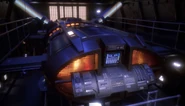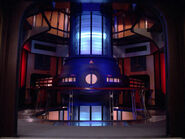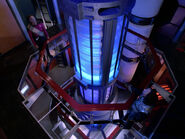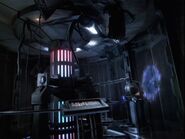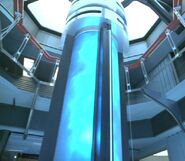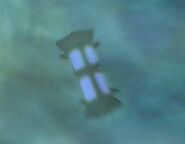m (changed 'drug by a tractor beam' to 'towed using a tractor beam' which seems to make more sense) |
m (→Gallery: linkfixes, - duplicate link) Tag: sourceedit |
||
| (40 intermediate revisions by 17 users not shown) | |||
| Line 1: | Line 1: | ||
| + | {{at|xx}} |
||
| ⚫ | '''Warp core''' is the common designation for the main [[energy]] reactor powering the [[propulsion]] system on [[warp]] |
||
| + | [[File:Yamato warp core.jpg|thumb|The internal location of a {{class|Galaxy}} warp core]] |
||
| ⚫ | '''Warp core''' is the common designation for the main [[energy]] reactor powering the [[propulsion]] system on [[warp capable]] [[starship]]s. During the [[22nd century]], '''warp reactors''' aboard {{class|NX}} starships were technically known as the "'''Gravimetric Field Displacement Manifold'''". ({{ENT|Cold Front}}) The reactor had eight major components. ({{ENT|Desert Crossing}}) A less common name for this core was '''antimatter reactor core'''. ({{TNG|Booby Trap}}, ''display graphic'') |
||
| − | On [[Federation]] starships, the warp core usually consists of a [[matter]]/[[antimatter]] [[matter-antimatter reaction assembly|reaction assembly]] (M/ARA) utilizing [[deuterium]] and [[antideuterium]] reacting in a crystal matrix which produces a maximum output of 4,000 [[teradyne]]s per second. ({{VOY|Drone |
+ | On [[Federation]] starships, the warp core usually consists of a [[matter]]/[[antimatter]] [[matter-antimatter reaction assembly|reaction assembly]] (M/ARA) utilizing [[deuterium]] and [[antideuterium]] reacting in a [[dilithium crystal]] matrix which produces a maximum output of 4,000 [[teradyne]]s per second. ({{VOY|Drone}}) |
| − | :''In the [[alternate reality]], dilithium crystals are utilized at least as early as [[2258]].'' ({{film|11}}) |
||
| − | 22nd century warp cores were designed as oblong cylinders connected by pylon conduits directly into the warp nacelles. In the 23rd century, the main warp reaction occurred in a [[dilithium crystal converter assembly]] which consisted of two flattened rounded nodules situated directly in front of the warp plasma conduits to the warp engines which were behind a large metal grate. By [[2270]], most Federation warp cores were redesigned to consist of a large warp core unit in the secondary hull with matter and |
+ | 22nd century warp cores were designed as oblong cylinders connected by pylon conduits directly into the warp nacelles. (''[[Star Trek: Enterprise]]'') In the [[23rd century]], the warp core was not situated in the main engineering. The main warp reaction occurred in a [[dilithium crystal converter assembly]] which consisted of two flattened rounded nodules situated directly in front of the warp plasma conduits to the warp engines, which were behind a large metal grate. (''[[Star Trek: The Original Series]]''; {{ENT|In a Mirror, Darkly, Part II}}) By [[2270]], most Federation warp cores were redesigned to consist of a large warp core unit in the secondary hull with matter and antimatter channeling into the core through vertical conduits, with the resulting energy directed to the nacelles through a horizontal conduit leading out from the rear of the core. ({{film|1}}) |
| + | {{bginfo|Of the original {{class|Constitution}} warp core, only the dilithium crystal assembly and the plasma conduits were ever seen in ''[[Star Trek: The Original Series]]''. When [[Doug Drexler]] was called to design [[:File:Constitution class schematics.jpg|the detailed schematics]] of a ''Constitution''-class starship, he designed a horizontal warp core that runs two decks below main engineering. ''{{DrexFiles|2009/02/09/never-on-xindi/#comment-1145}}'' The schematic made a prominent appearance on screen in {{ENT|In a Mirror, Darkly, Part II}}. ''[[Star Trek: The Animated Series]]'' also featured [[:File:Warp core TAS.jpg|a vertical component]] of the warp core, that extended from the dilithium crystal assembly.}} |
||
| − | :''The vertical warp core was never seen in ''[[Star Trek: The Original Series]]'' (although there was one in [[TAS]] in what seemed to be a modification). During this time, main engineering contained two flattened nodules, situated directly in front of a large metal grate, which were shown as key components of the warp drive (likely to be warp plasma conduits to the warp engines). There may have been a warp core below decks but was never seen on screen. The vertical warp core's first appearance was in {{film|1}} and was seen in all subsequent ''Star Trek'' productions set after TOS.'' |
||
| − | As a safety precaution, the core |
+ | As a safety precaution, the core could be physically [[Warp core ejection system|ejected]] from the ship, should an event such as a catastrophic containment failure of the [[matter-antimatter reaction]] occur that cannot be corrected. There were also some tactical uses for ejecting and detonating a core on purpose. The detonation could for example be used to neutralize the cascade of a [[subspace tear]] or push a ship away from the [[gravity well]] of a [[black hole]]. ({{TOS|That Which Survives}}; {{TNG|Cause and Effect|All Good Things...}}; {{VOY|Cathexis|Day of Honor|Renaissance Man}}; {{film|9}}; {{film|11}}) |
| − | [[Antimatter containment]] is achieved through the use of magnetic fields, which guide and direct the antimatter through the [[antimatter engine]] to [[antimatter injector|injector]] coils, which precisely compresses and streams the antimatter into the form which enters the [[dilithium articulation frame]]. Deuterium, stored in the ship or attracted by the [[Bussard collector]]s, is funneled in a stream from the opposite [[deuterium injector]]. The molecules enter the lattice matrix of the crystallized dilithium, reacting within it and releasing a tuned energy stream in the form of [[electro-plasma]], a highly energetic form of [[plasma]]. The electro-plasma is carried by [[plasma conduit|magnetic plasma conduits]] throughout the power transfer system. In the Federation [[power transfer grid]], this is the [[electro-plasma system|electro-plasma distribution network]], |
+ | [[Antimatter containment]] is achieved through the use of magnetic fields, which guide and direct the antimatter through the [[antimatter engine]] to [[antimatter injector|injector]] coils, which precisely compresses and streams the antimatter into the form which enters the [[dilithium articulation frame]]. Deuterium, stored in the ship or attracted by the [[Bussard collector]]s, is funneled in a stream from the opposite [[deuterium injector]]. The molecules enter the lattice matrix of the crystallized dilithium, reacting within it and releasing a tuned energy stream in the form of [[electro-plasma]], a highly energetic form of [[plasma]]. The electro-plasma is carried by [[plasma conduit|magnetic plasma conduits]] throughout the power transfer system. In the Federation [[power transfer grid]], this is the [[electro-plasma system|electro-plasma distribution network]], comprised of [[EPS conduit]]s and [[EPS tap]]s. The most energized stream created is the [[warp plasma]], which exits in twin [[power transfer conduit]]s connected to the warp [[nacelle]]s. ({{ENT|Cold Front|These Are the Voyages...}}; {{film|9}}) |
| − | During the [[23rd century]], dilithium crystals were also used in [[Klingon]] warp reactions to generate energy at sufficient levels to enable warp flight. |
+ | During the [[23rd century]], dilithium crystals were also used in [[Klingon]] warp reactions to generate energy at sufficient levels to enable warp flight. In the late [[24th century]], Klingon reactors used a [[tritium intermix]], a feature not included in Federation and [[Romulan]] ships of the same era. ({{DS9|When It Rains...}}) On Romulan starships, a completely different approach was used; an [[artificial quantum singularity]] in the warp core was used to harness the energy necessary to power warp flight. ({{TNG|Timescape}}) |
| ⚫ | |||
| − | On [[Romulan]] starships, a different approach is used; an [[artificial quantum singularity]] in the warp core is used to harness the energy necessary to power warp flight. ({{TNG|Timescape}}) |
||
| ⚫ | |||
| − | In [[2369]], [[Quark]] and [[Barbo]] sold defective warp cores to the [[Tarahongian]]s. ({{DS9|The Nagus}}) |
||
| + | When a warp core went offline, deuterium was vital to support basic functions of a ship. Warp cores from shuttlecraft and shuttlepods could augment power if necessary. ({{VOY|The Void}}) |
||
| ⚫ | |||
| − | |||
| ⚫ | |||
==Gallery== |
==Gallery== |
||
| − | <gallery> |
+ | <gallery captionalign="left"> |
| − | + | File:NX class warp core.jpg|The warp core of an {{class|NX}} starship |
|
| − | + | File:USS Enterprise (alternate universe) warp cores.jpg|Multiple warp cores of the {{class|Constitution|alternate reality}}<br />([[alternate reality]], [[2258]]) |
|
| − | + | File:Constitution class warp core exterior, alternate reality.jpg|The exterior of the warp core of the ''Constitution''-class<br />(alternate reality, [[2259]]) |
|
| − | + | File:Constitution class warp core interior, alternate reality.jpg|The interior of the warp core of the ''Constitution''-class<br />(alternate reality, 2259) |
|
| − | + | File:Constitution original engineering2.jpg|The warp core of a {{class|Constitution}} starship ([[2266]]) |
|
| − | + | File:Constitution class refit engineering.jpg|The warp core of a {{class|Constitution}} refit starship ([[2270s]]) |
|
| − | + | File:Constitution Engineering.jpg|The warp core of a {{class|Constitution}} refit starship ([[2293]]) |
|
| − | + | File:USS Hathaway warp core.jpg|The warp core of a {{class|Constellation}} starship |
|
| − | + | File:Galaxy class warp core.jpg|A forward view of a warp core on a {{class|Galaxy}} starship |
|
| − | + | File:Galaxy warp core elevated view.jpg|An elevated view of the warp core on a ''Galaxy''-class starship |
|
| − | + | File:Defiant Main Engineering.jpg|The warp core of a {{class|Defiant}} starship |
|
| + | File:USS Equinox warp core.jpg|The enhanced warp core of a {{class|Nova}} starship |
||
| + | File:VoyagerWarpCore.jpg|The warp core of an {{class|Intrepid}} starship |
||
| + | File:Sovereign Warp Core.jpg|The warp core of a {{class|Sovereign}} starship |
||
| + | File:Delta Flyer warp core.jpg|The warp core of the ''[[Delta Flyer II]]'' shuttle |
||
| + | File:Dderidex-engine core.jpg|The engine core of a {{class|D'deridex}} warbird |
||
</gallery> |
</gallery> |
||
==Further references== |
==Further references== |
||
*{{DS9|The Visitor}} |
*{{DS9|The Visitor}} |
||
| − | |||
| − | |||
| − | |||
[[cs:Warp jádro]] |
[[cs:Warp jádro]] |
||
[[de:Warpkern]] |
[[de:Warpkern]] |
||
[[es:Núcleo Warp]] |
[[es:Núcleo Warp]] |
||
| + | [[fr:Réacteur de distorsion]] |
||
| + | [[it:Nucleo di curvatura]] |
||
| + | [[ja:ワープ・コア]] |
||
[[mu:Warp reactor]] |
[[mu:Warp reactor]] |
||
[[nl:Warpkern]] |
[[nl:Warpkern]] |
||
| − | [[Category: |
+ | [[Category:Warp]] |
[[Category:Energy technology]] |
[[Category:Energy technology]] |
||
Revision as of 09:23, 16 August 2015
AT: "xx"

The internal location of a Galaxy-class warp core
Warp core is the common designation for the main energy reactor powering the propulsion system on warp capable starships. During the 22nd century, warp reactors aboard NX-class starships were technically known as the "Gravimetric Field Displacement Manifold". (ENT: "Cold Front") The reactor had eight major components. (ENT: "Desert Crossing") A less common name for this core was antimatter reactor core. (TNG: "Booby Trap", display graphic)
On Federation starships, the warp core usually consists of a matter/antimatter reaction assembly (M/ARA) utilizing deuterium and antideuterium reacting in a dilithium crystal matrix which produces a maximum output of 4,000 teradynes per second. (VOY: "Drone")
22nd century warp cores were designed as oblong cylinders connected by pylon conduits directly into the warp nacelles. (Star Trek: Enterprise) In the 23rd century, the warp core was not situated in the main engineering. The main warp reaction occurred in a dilithium crystal converter assembly which consisted of two flattened rounded nodules situated directly in front of the warp plasma conduits to the warp engines, which were behind a large metal grate. (Star Trek: The Original Series; ENT: "In a Mirror, Darkly, Part II") By 2270, most Federation warp cores were redesigned to consist of a large warp core unit in the secondary hull with matter and antimatter channeling into the core through vertical conduits, with the resulting energy directed to the nacelles through a horizontal conduit leading out from the rear of the core. (Star Trek: The Motion Picture)
As a safety precaution, the core could be physically ejected from the ship, should an event such as a catastrophic containment failure of the matter-antimatter reaction occur that cannot be corrected. There were also some tactical uses for ejecting and detonating a core on purpose. The detonation could for example be used to neutralize the cascade of a subspace tear or push a ship away from the gravity well of a black hole. (TOS: "That Which Survives"; TNG: "Cause and Effect", "All Good Things..."; VOY: "Cathexis", "Day of Honor", "Renaissance Man"; Star Trek: Insurrection; Star Trek)
Antimatter containment is achieved through the use of magnetic fields, which guide and direct the antimatter through the antimatter engine to injector coils, which precisely compresses and streams the antimatter into the form which enters the dilithium articulation frame. Deuterium, stored in the ship or attracted by the Bussard collectors, is funneled in a stream from the opposite deuterium injector. The molecules enter the lattice matrix of the crystallized dilithium, reacting within it and releasing a tuned energy stream in the form of electro-plasma, a highly energetic form of plasma. The electro-plasma is carried by magnetic plasma conduits throughout the power transfer system. In the Federation power transfer grid, this is the electro-plasma distribution network, comprised of EPS conduits and EPS taps. The most energized stream created is the warp plasma, which exits in twin power transfer conduits connected to the warp nacelles. (ENT: "Cold Front", "These Are the Voyages..."; Star Trek: Insurrection)
During the 23rd century, dilithium crystals were also used in Klingon warp reactions to generate energy at sufficient levels to enable warp flight. In the late 24th century, Klingon reactors used a tritium intermix, a feature not included in Federation and Romulan ships of the same era. (DS9: "When It Rains...") On Romulan starships, a completely different approach was used; an artificial quantum singularity in the warp core was used to harness the energy necessary to power warp flight. (TNG: "Timescape")
Warp cores on starships left resonance traces, allowing for the ability to track vessels. (VOY: "Caretaker")
A warp core could be towed at warp using a tractor beam if calibrated properly. (VOY: "Day of Honor", "Renaissance Man")
When a warp core went offline, deuterium was vital to support basic functions of a ship. Warp cores from shuttlecraft and shuttlepods could augment power if necessary. (VOY: "The Void")
Gallery
(alternate reality, 2259)
(alternate reality, 2259)
Further references
- DS9: "The Visitor"

